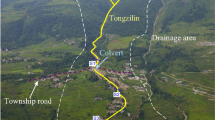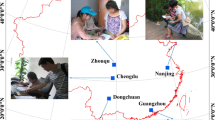Abstract
Debris flows cause significant damage and fatalities throughout the world. This study addresses the overall impacts of debris flows on a global scale from 1950 to 2011. Two hundred and thirteen events with 77,779 fatalities have been recorded from academic publications, newspapers, and personal correspondence. Spatial, temporal, and physical characteristics have been documented and evaluated. In addition, multiple socioeconomic indicators have been reviewed and statistically analyzed to evaluate whether vulnerable populations are disproportionately affected by debris flows. This research provides evidence that higher levels of fatalities tend to occur in developing countries, characterized by significant poverty, more corrupt governments, and weaker healthcare systems. The median number of fatalities per recorded deadly debris flow in developing countries is 23, while in advanced countries, this value is only 6 fatalities per flow. The analysis also indicates that the most common trigger for fatal events is extreme precipitation, particularly in the form of large seasonal storms such as cyclones and monsoon storms. Rainfall caused or triggered 143 of the 213 fatal debris flows within the database. However, it is the more uncommon and catastrophic triggers, such as earthquakes and landslide dam bursts, that tend to create debris flows with the highest number of fatalities. These events have a median fatality count >500, while rainfall-induced debris flows have a median fatality rate of only 9 per event.





















Similar content being viewed by others
References
Barredo JL (2007) Major flood disasters in Europe: 1950–2005. Nat Hazards 42:125–148
Cruden DM, Varnes DJ (1996) Landslide types and processes. In: Turner AK, Schuster RL (eds) Landslides investigation and mitigation. Transportation Research Board, National Research Council, Washington, pp 64–67
Fuchs S, Heiss K, Hübl J (2007) Towards an empirical vulnerability function for use in debris flow risk assessment. Nat Hazards Earth Syst Sci 7:495–506
Garcia-Martinez R, Lopez JL (2005) Debris flows of December 1999 in Venezuela. In: Hungr O, Jakob M (eds) Debris-flow hazards and related phenomena. Springer-Praxis, Berlin, pp 519–538
Gleditsh KS (2002) Expanded trade and GDP data. J Confl Resolut 46:712–724
Guadagno FM, Revellino P (2005) Debris avalanches and debris flows of the Campania Region (southern Italy). In: Hungr O, Jakob M (eds) Debris-flow hazards and related phenomena. Springer-Praxis, Berlin, pp 489–518
Guzetti F, Stark CP, Salvati P (2005) Evaluation of flood and landslide risk to the population of Italy. Environ Manag 36(1):15–36
Hewitt K (1997) Regions of risk: a geographical approach to disasters. Addison Wesley Longman, London
Hungr O, Evans SG, Bovis MJ, Hutchinson JN (2000) A review of the classification of landslides of the flow type. Environ Eng Geosci 7(3):221–238
International Monetary Fund (2011) World economic outlook (WEO) tensions from the two-speed recovery: unemployment, commodities, and capital flows. International Monetary Fund, Washington
Iverson RM (2005) Debris flow mechanics. In: Hungr O, Jakob M (eds) Debris-flow hazards and related phenomena. Springer-Praxis, Berlin, pp 105–134
Jakob M, Hungr O (2005) Introduction. In: Hungr O, Jakob M (eds) Debris-flow hazards and related phenomena. Springer-Praxis, Berlin, pp 1–7
Jakob M, Stein D, Ulmi M (2011) Vulnerability of buildings to debris flow impact. Nat Hazards 52(1):241–261
Jan CD, Chen CL (2005) Debris flows caused by Typhoon Herb in Taiwan. In: Hungr O, Jakob M (eds) Debris-flow hazards and related phenomena. Springer-Praxis, Berlin, pp 539–563
Kachigan SK (1991) Multivariate statistical analysis. Radius Press, New York
Kanji MA, Massad F, Cruz PT (2003) Debris flows in areas of residual soils: occurrence and characteristics. International workshop on occurrence and mechanisms of flows in natural slopes and Earthfills, Associacione Geotecnica Italiana, Sorrento, Italy
Petley DN (2012a) Global patterns of loss of life from landslides. Geology 40(10):927–930
Petley DN (2012b) The landslide blog. American Geophysical Union. http://blogs.agu.org/landslideblog. Accessed 12 March 2012
Petley DN, Dunning SA, Rosser NJ (2005) The analysis of global landslide risk through the creation of a database of worldwide landslide fatalities. In: Hungr O, Fell R, Couture R, Eberhardt E (eds) Landslide risk management. Taylor and Francis Group, London, pp 367–374
Salvati P, Bianchi C, Rossi M, Guzzetti F (2010) Societal landslide and flood risk in Italy. Nat Hazards Earth Syst Sci 10(3):465–483
Sanchez C, Lee TS, Young S, Batts D, Benjamin J, Malilay J (2009) Risk factors for mortality during the 2002 landslides. Disasters 33(4):705–720
Santi PM, Hewitt K, VanDine DF, Barillas EM (2010) Debris-flow impact, vulnerability, and response. Nat Hazards 56(1):371–402
Totschnig R, Sedlacek W, Fuchs S (2011) A quantitative vulnerability function for fluvial sediment transport. Nat Hazards 58(2):681–703
Tukey JW (1977) Exploratory data analysis. Addison-Wesley, Reading
Varnes DJ (1978) Slope movement types and processes. In: Schuster RL, Krizek RJ (eds) Special report 176: landslides: analysis and control. Transportation Research Board, National Research Council, Washington, pp 11–33
Acknowledgments
The authors wish to thank Samantha Jacob, Lauren Santi, and Tara Santi for initial literature review in assembling the database. We are grateful to Dr. David N. Petley of the Landslide Blog, the Association of Engineering and Environmental Geologists, and the Environmental and Engineering Geology Division of the Geological Society of America for soliciting professionals to provide information on debris-flow events.
Author information
Authors and Affiliations
Corresponding authors
Rights and permissions
About this article
Cite this article
Dowling, C.A., Santi, P.M. Debris flows and their toll on human life: a global analysis of debris-flow fatalities from 1950 to 2011. Nat Hazards 71, 203–227 (2014). https://doi.org/10.1007/s11069-013-0907-4
Received:
Accepted:
Published:
Issue date:
DOI: https://doi.org/10.1007/s11069-013-0907-4




